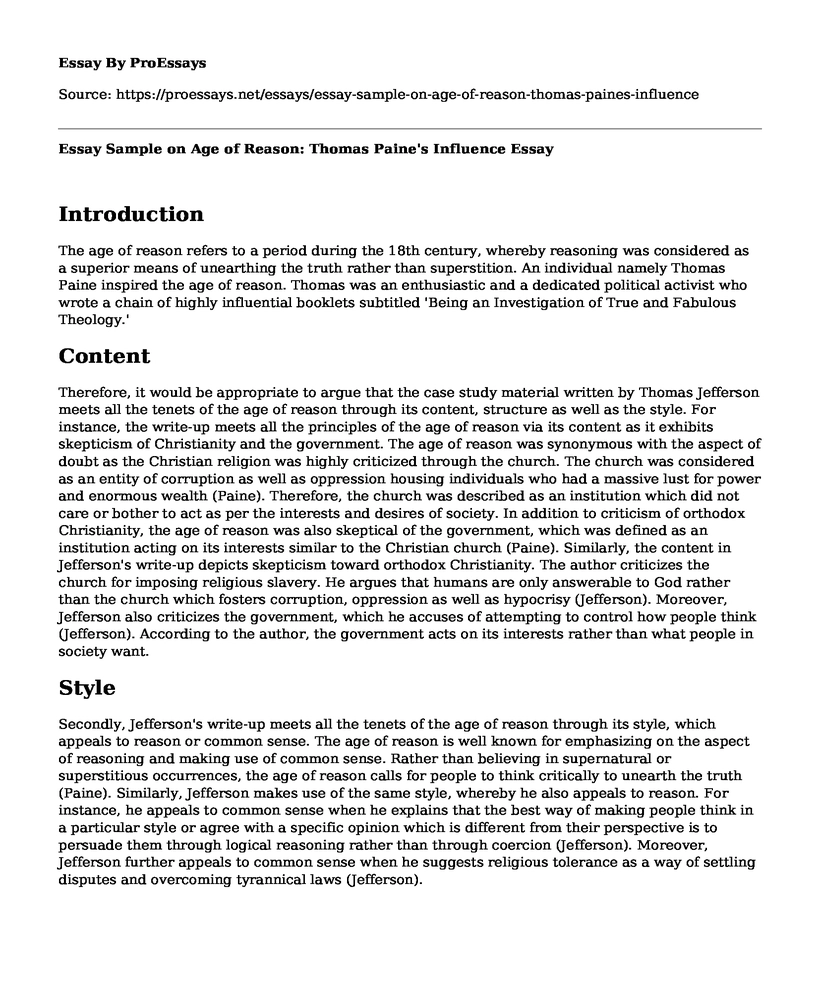Introduction
The age of reason refers to a period during the 18th century, whereby reasoning was considered as a superior means of unearthing the truth rather than superstition. An individual namely Thomas Paine inspired the age of reason. Thomas was an enthusiastic and a dedicated political activist who wrote a chain of highly influential booklets subtitled 'Being an Investigation of True and Fabulous Theology.'
Content
Therefore, it would be appropriate to argue that the case study material written by Thomas Jefferson meets all the tenets of the age of reason through its content, structure as well as the style. For instance, the write-up meets all the principles of the age of reason via its content as it exhibits skepticism of Christianity and the government. The age of reason was synonymous with the aspect of doubt as the Christian religion was highly criticized through the church. The church was considered as an entity of corruption as well as oppression housing individuals who had a massive lust for power and enormous wealth (Paine). Therefore, the church was described as an institution which did not care or bother to act as per the interests and desires of society. In addition to criticism of orthodox Christianity, the age of reason was also skeptical of the government, which was defined as an institution acting on its interests similar to the Christian church (Paine). Similarly, the content in Jefferson's write-up depicts skepticism toward orthodox Christianity. The author criticizes the church for imposing religious slavery. He argues that humans are only answerable to God rather than the church which fosters corruption, oppression as well as hypocrisy (Jefferson). Moreover, Jefferson also criticizes the government, which he accuses of attempting to control how people think (Jefferson). According to the author, the government acts on its interests rather than what people in society want.
Style
Secondly, Jefferson's write-up meets all the tenets of the age of reason through its style, which appeals to reason or common sense. The age of reason is well known for emphasizing on the aspect of reasoning and making use of common sense. Rather than believing in supernatural or superstitious occurrences, the age of reason calls for people to think critically to unearth the truth (Paine). Similarly, Jefferson makes use of the same style, whereby he also appeals to reason. For instance, he appeals to common sense when he explains that the best way of making people think in a particular style or agree with a specific opinion which is different from their perspective is to persuade them through logical reasoning rather than through coercion (Jefferson). Moreover, Jefferson further appeals to common sense when he suggests religious tolerance as a way of settling disputes and overcoming tyrannical laws (Jefferson).
Structure
Last but not least, the write-up by Jefferson meets all the tenets of the age of through its anatomy, which presents its argument systematically. In the age of reason, arguments were presented consistently to prove a certain point. An excellent example is exhibited by Thomas Paine who portrayed his philosophical discussion in favor of deism by first giving his perspective regarding orthodox Christianity followed by an analysis that describes the bible is not God's word as Christians claim (Paine). The same aspect is evident in Jefferson's journal, whereby he exhibits systematic thinking. He begins by presenting a scenario which forms the basis for his argument (Jefferson). Afterward, he delves into an evaluation of the situation whereby he portrays both the church and government as entities of corruption and oppression to the people.
Conclusion
Hence, as depicted, the write-up by Jefferson meets all the tenets of the age of reason. The principles of the age of reason, which are namely skepticism, appeal to common sense, and systematic thinking is exhibited through the write-up's content, structure, and style. The material shows the write-up's skepticism towards the Christian religion. Moreover, the composition exhibits systematic thinking while the form portrays an appeal to common sense.
Works Cited
Jefferson, Thomas. "Notes On The State Of Virginia: Query XVII: Religion - Teaching American History". Teaching American History, 1781,
https://teachingamericanhistory.org/library/document/notes-on-the-state-of-virginia-query-xvii-religion/. Accessed 31 May 2019.
Paine, Thomas. Age of reason. RS Bear, 2000.
www.scholarsbank.uoregon.edu/xmlui/bitstream/handle/1794/841/reason.pdf?sequence. Accessed 31 May 2019.
Cite this page
Essay Sample on Age of Reason: Thomas Paine's Influence. (2023, Jan 16). Retrieved from https://proessays.net/essays/essay-sample-on-age-of-reason-thomas-paines-influence
If you are the original author of this essay and no longer wish to have it published on the ProEssays website, please click below to request its removal:
- Slavery and Oppression of the Blacks From 1865 to Present United States
- Ching-Hung Woo Says Freedom Is Compatible With Choices Being Determined
- Consideration Letter on Bill No. H.R. 1538 About Nuclear Weapons Paper Example
- The Lost Cause, the New South, the Agrarian Revolt Essay
- The Concept of Government Regulation of Social Media Paper Example
- Essay Sample on Modern Bureaucracy: A Systematic Organization of Governments
- Post-WWII Literature: Examining the Dark Side of Humanity - Essay Sample







